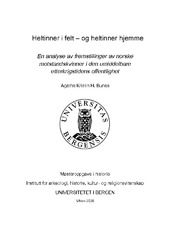| dc.description.abstract | This thesis analyses how women were portrayed in the media in the immediate post-war period, as a part of the resistance against the Nazis during World War II. Women as a part of the resistance movement were highly celebrated in the media, and there is a vast material of representations, which was surprising considering previous research on this field has alleged that ‘the heroine’ had been made invisible in the post-war society. This thesis discusses how the representations of women could be understood in the context at that time – acknowledging contemporary structures, ideals and gender norms. I identify two main roles women were presented with; the heroine in organized resistance movement, and the heroine in the role as a housewife. The two main chapters in this study consist of these two categories and examine what abilities, characteristics and tasks the women were ascribed. The first chapter concerns women as an active part of the organized resistance movement. This chapter examine four categories of presenting the women. The first category deals with how she was portrayed as a part of the resistance movement without gender being at focus. The second category discusses how she was formed as an ‘ideal’ woman with features and qualities considered idealistic at the time, which were being presented as central factors for her to be a heroine. The third category concerns how she was formed as a ‘manly’ heroine where she was ascribed masculine characteristics and presented to be in a man sphere. The fourth category discusses how women sometimes were assigned the role as a subordinate helper to male heroes, but she was still portrayed as a valuable heroine. The second chapter concerns how housewives were portrayed as a part of the resistance movement. This chapter operates with two main categories of how they were portrayed. The first category deals with how housewives were recognized as a part of, and basis for, the resistance movement by doing their daily, domestic duties. The second category concerns how housewives were portrayed with illegal activities, but how these tasks were still presented as an extension of the housewife’s domestic duties. In both categories, ideas related to the domestic ideal were being largely emphasized. Both chapters also discuss how women’s participation in the resistance movement were portrayed in a political debate, for political gain. Women’s efforts and contributions during wartime were in many ways used as arguments to promote both political activisation in women, and to strengthen women’s position in society – as equals to men, and as housewives. | en_US |
